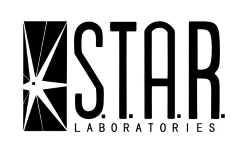STAR Labs
From TheHolo.Net Forums Wiki
| ||||||||||||||||||||||||||||||||
Contents |
The Science and Technology Advanced Research Laboratories Initiative, or S.T.A.R. Labs program, is a system of facilities and laboratories overseen by the United States Department of Energy (DOE) for the purpose of advancing science and technology. Through a mix of federal and private funding, STAR Labs facilities research everything from theoretical physics to applied pharmacology, working both with institutes of higher learning and with military contractors to further advance humanity's understanding of science and nature, and to advance the technological levels of the United States. In recent years, they have become best known for their research into metahumans and extraterrestrials, developing countermeasures for law enforcement as well as investigating their physiology and technology for new understanding that might advance human science and medicine.
STAR Labs works alongside a number of other government and semi-governmental agencies and organisations, including NASA, DARPA, and ARGUS. They are equivalent to the national laboratories of Earth Zero (the "real world").
History
The first "StarLab" predates the Department of Energy by several decades. It was established by Theodore Knight: an Allied scientist during the Second World War, who became the costumed crimefighter known as Starman. He had participated in the Manhattan Project during the war, but rather than remain with the military and continue his research at facilities like Area 51, he instead returned to his native Opal City, and opened his own modest laboratory. Ted Knights interest - and the origin of his costumed abilities - lay in particle physics, a field of research that STAR Labs Opal City continues to specialise in today.
Following Ted Knight's death, ownership of his laboratory was inherited by his sons. However, neither of the Knight boys had any interest in owning or using a laboratory, and so it was acquired by Starman's protégé, young socialite Sylvester Pemberton. As the so called "Golden Age" of costumed heroics came to a close, Pemberton had begun to transition from his life as the Star Spangled Kid into a career in politics, and used his connections - as well as his considerable hereditary wealth - to create the STAR Labs Initiative, funded in part by the federal government, and in part by himself and other private investors. The inaugural STAR laboratory was built in Pemberton's native Star City, as a cutting edge research and development facility. By virtue of geography and proximity, STAR Labs Star City - often called Pemberton Labs - formed a close working relationship with the ARGUS agency, providing R&D support to their operations.
In the wake of the Second World War, the United States military had engaged in a number of research projects, furthering the work of wartime initiatives like the Manhattan Project, and Project M. Following the creation of the Department of Energy, many of these projects were handed over to ARGUS and STAR Labs; though some continued to be pursued by DARPA and other branches of the Department of Defense. To foster cooperation between the DOD and DOE, the STAR Labs initiative founded Mercury Labs, a top secret research facility located in the scientist township of Mercury, Nevada, close to the military's Area 51 base. Much of the research at Mercury Labs is classified, though rumours and conspiracy theories credit the facility with involvement in alien dissection and extraterrestrial technologies.
The crown jewel of STAR Labs is arguably STAR Labs Metropolis. Beginning as a proving ground established at a disused airfield a few miles from Metropolis, the facility has expanded over the years into an entire campus and community of research and development, with various corporations and institutions setting up their own labs and facilities at the site. The Metropolis Labs not only acts as a research complex, but also as a museum and education center, catering to visits from schools and academic institutions, and even offers its own postgraduate programs in association with Metropolis University and other institutions of higher learning. It is the closest STAR Labs facility to Gotham, and boasts research buildings funded by both Wayne Enterprises and Queen Consolidated. It is also has some association with ARGUS' Justice League initiative.
STAR Labs' newest facility is STAR Labs Central City, confusingly located in Keystone City, just across the Kansas-Missouri border from Central City. Constructed at the turn of the century, the main focus of the facility was an advanced particle accelerator, designed to study high energy particles and investigate the existence of hypothetical tachyon particles. While the accelerator succeeded in proving the existence of those particles, it also triggered the release of an explosive wave of hyperspace radiation that swept across Central and Keystone City, triggering the latent metagene in many individuals. The incident triggered a surge in metahumans that the United States was not equipped to handle. As restitution, STAR Labs has spent the last decade assisting the Department of Extranormal Operations in detecting and containing criminal metahumans, including the creation of a "supermax" metahuman detention facility at Iron Heights Penitentiary.
Hierarchy
As STAR Labs is not a single entity or corporation, there is very little centralised hierarchy between the various facilities. Each facility is overseen by an independent Director or Administrator, or in some cases both, with the former directing research and the latter overseeing the administration of facilities and finances.
At a governmental level, most sites are overseen by the Department of Energy's Office of Science Laboratories, though there are some laboratories that are not; and indeed, there are some laboratories funded by the Department of Energy that are not part of the STAR Labs initiative. Funding for all national laboratories, including STAR Labs, is overseen by the United States Senate Commerce Subcommittee on Space, Science, and Competitiveness; currently chaired by Senator Sylvester Pemberton.
STAR Labs Employees
- StarLab (Opal City)
- Pemberton Labs (Star City)
- Mercury Labs (Area 51)
- Christina McGee (Administrator)
- STAR Labs Metropolis
- Jeremiah McGee (Director)
- Malcolm Duncan (former)
- Jeremiah McGee (Director)
- STAR Labs Central City



